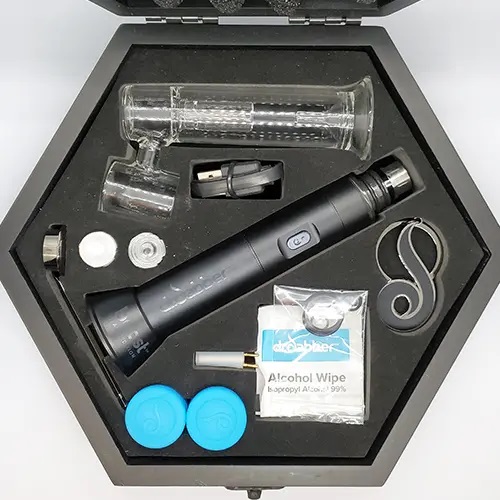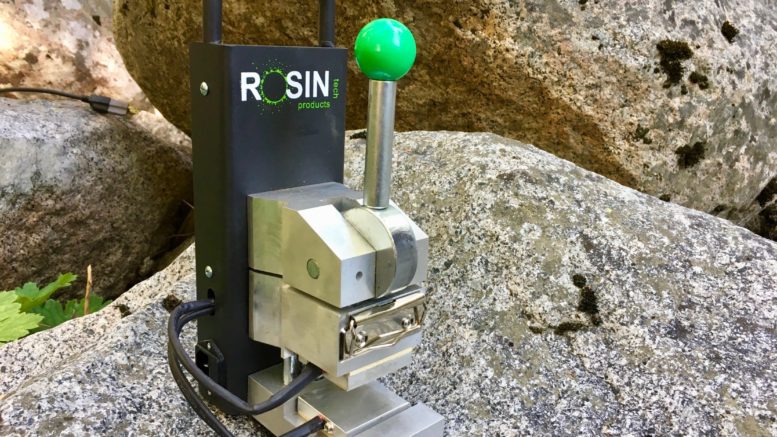SN&R’s cannabis writer re-reviews four of his past cannabis equipment purchases
by Ken Magri
This is my 150th cannabis article for the Sacramento News and Review. In the last five years, I have written about several interesting new cannabis inventions and devices.
Now seems like a great time to take a second look at four of the more pricey items I purchased and reviewed, to determine whether they are still worth the price, and how well they held up over the years.
The Genius Pipe, a carry-anywhere cannabis pipe
The Genius Pipe is a metal pocket pipe with top and bottom layers, and a sliding cover, all held together by strong magnets. Designed to be easily carried around, its features hundreds of “dimples” on the inside that cool the inhale to make it easier on the throat.
Here is what I originally wrote in “Sneak a Toke” (SN&R 10/08/18).
“Only the $80 cost slowed me down. Then I saw their limited-edition Stanley Mouse/Alton Kelley version, featuring the Psychedelic artists’ rose-covered skeleton of Grateful Dead fame. Suddenly, price meant nothing and I bought a Genius Pipe for $120.”
This is a product I was really rooting for. I could pack a bowlful, carry the pipe around in my pocket, and pull it out for a quick hit anytime. The draw was smooth and steady, and its dimples really did cool the smoke down. Their replacement screens are sturdy, and despite criticism from online reviewers, I found the device was easy to clean.
I could set it down on a table and it looked more like a skinny cell phone than a pot pipe. This was so cool!
But over time I noticed that the black anodized finish on the aluminum surface was wearing off on the inside, leaving bare metal underneath. Anodizing is an electrochemical process that forms a protective coating of aluminum oxide on the surface of aluminum.
Was I inhaling aluminum oxide (considered a hazardous work material) into my lungs with every hit? “The lifetime of the finish is proportional to the thickness of the anodic coating applied,” says the Southern Aluminum Finishing Company’s website. That’s a fancy way of saying that, yes, aluminum oxide coatings wear off.
But I totally stopped using the Genius Pipe after one of the magnets fell out of its corner sockets. It was no longer air tight, and wouldn’t deliver a good hit unless I rubber-banded it together.
When I reinserted the magnet, I forgot to check the polarity (hello, fourth grade science lesson!), and super-glued it in backwards. One corner of the pipe was now pushing away while the other three corners were trying to stick together. The pipe worked worse than before.
As for technical support, the Genius Pipe folks were almost worthless. After explaining my reverse-polarity super glue mistake, they took a few days to finally respond, saying that they had no ideas, but offering a discount on a new Genius Pipe.
No thanks.

But now, three years later, the Genius Pipe has a competitor, a Chinese knock-off that sells online at DHgate.com for under $20. I bought one, thinking I could cannibalize the bottom half and fix my Genius Pipe. But this new pipe’s magnets worked so poorly that the individual parts hardly held together.
In the end, the Genius Pipe is the product I loved the most, and most wanted to work well, but I can no longer recommend it. Furthermore, I advise consumers to never use a cannabis pipe, or a grinder, with an anodized aluminum coating on the inside.
The tCheck-2 cannabis THC potency test kit
I first used the tCheck-2 potency tester for a batch of canna-butter that was featured in “Potently Delicious” (SN&R, 4/18/19), an article about cannabis edibles. With homemade edibles, determining the accurate potency is a must for avoiding overdoses. I needed a reliable way to test potency before giving out edible recipes in the form of a newspaper article.
This is what I wrote back in 2019:
“With just drops of butter, oil or alcohol, it accurately measures the strength of the cannabis infusion in less than a minute. Although this home test kit is expensive (nearly $300), it’s portable and does work well. My canna-butter batch tested at 18.2 percent potency.”
And that 18.2% potency felt consistent with the strength of the canna-brownies I made. Here is a product that works right every time, and allows people to check the potency of their cannabis products by linking up with a free app and a smart phone.

How accurate is it?
Although tCheck-2 lists its accuracy variance at 15 percent, independent tests
showed that the average variance was in a range between 3 and 6.4 percent. I have not used the test kit in years, however, because once the ingredient amounts in my edible recipes were established, testing each batch became a needless redundancy.
But considering the cost for professional lab testing, the tCheck-2 is a great alternative for anyone growing cannabis at home who wants to make their own edibles, oils and tinctures.
The Rosin Tech Go2 live-rosin maker
The Rosin Tech Go is an entry level rosin maker that is small enough to fit in a backpack, and retails for $299. The next jump in price was Rosin Tech’s heftier Twist, a $450 bolt-down table model. But I was more interested in something portable and relatively inexpensive, in case rosin-making at home turned out to be a bust.
In the original article “Kicking it Live” (SN&R, 10/24/19), I speculated about buying that table model, wondering if the tiny Go model would be hefty enough.
“With only 700 pounds of pressure, would this 12.5 pound press perform like the big machines?”
And the final answer was no. It turned out that the Rosin Tech Go’s aluminum cam lever did not generate nearly enough pressure. While the machine did indeed make rosin, it left too much THC back inside the raw cannabis, now smashed down into square “puck” shapes. I had to make canna-butter out of the leftover pucks to recover that lost THC.
After viewing the Rosin Tech videos on You Tube, my son and I tried again with different temperature settings, and got about the same results. We harvested two hits worth of rosin from a pair of cannabis buds, but could see too much leftover THC shimmering on the outside of the puck. We wondered how much was still inside.
My son said the Rosin Tech Go reminded him of a crayon-making machine we had when he was a child. “You know, it worked fine,” he said, “but it just didn’t make very good crayons.”
I thought about trying the Rosin Tech Go one last time before criticizing it in this article. But I misplaced the electric cord, and a replacement costs $25, with shipping. In light of the machine’s first two try-outs, we decided instead to earmark the $25 towards a new, better rosin maker. Now I wish I had gone for the more expensive Twist model.
The newest Rosin Tech Go 2.0 has been improved and is 25% lighter, but still only delivers 700 pounds of pressure. In my opinion, that is the major design flaw. It wastes good cannabis buds.
I would only recommend the Rosin Tech Go for someone who has lots of extra cannabis to play around with, or who knows how to convert smashed THC pucks into canna-butter.
The Dr. Dabber Boost Black Edition electronic dabbing device
The Dr. Dabber Boost, Black Edition is a portable electronic dab rig, also called an “e-rig” or an “e-nail.” This $149 entry-level machine is designed for smoking (or “dabbing”) cannabis concentrates.
Packaged in a black octagon box, the Boost comes with lots of little extras, like a charger, a replacement heat unit, a magnetic carb cap, alcohol wipes, two silicone rosin containers and three separate nails of glass, ceramic and titanium. It is everything one needs to start dabbing, except for the cannabis concentrate.
Like a vape battery, the Boost’s colored blinking lights indicate when the unit is hot enough for a dab. It takes about 30 seconds to heat up, which is standard for e-rigs. Any leftover concentrate liquid can be poured into one of the silicone storage containers, and the individual parts clean up easily with isopropyl alcohol.

This is a great product that I used several times during research for other articles, but never reviewed. In this case, I give it thumbs-up, but with the following caveat.
The Boost is an entry-level machine, and not designed for heavy use. The heat temperatures are all pre-set, which means that the three different nails won’t work the same on different kinds of concentrates. But for occasional light dabbers, or people on the move, this little black box sells for a fair price and packs a lot of fun inside.


Be the first to comment on "How the canna-toys held up"